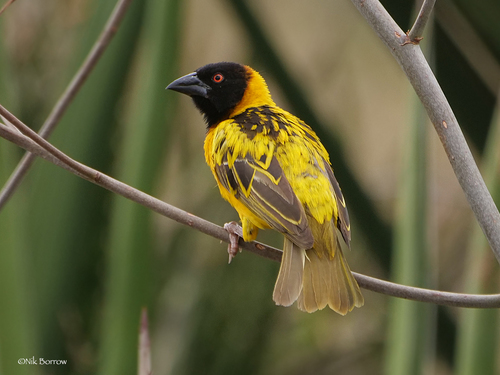
Village Weaver
The Village Weaver (*Ploceus cucullatus*) is a highly social and abundant bird species native to sub-Saharan Africa. Known for its intricate woven nests and boisterous colonies, it plays a significant role in its ecosystem as both a seed disperser and prey for various predators. It has also been introduced to various regions, including some Caribbean islands and parts of the Indian Ocean. The species is culturally significant in some regions, often appearing in folklore and traditional crafts. Its adaptability has allowed it to thrive in various habitats, including human-altered landscapes.
15-18 cm
Length
22-25 cm
Wingspan
Least Concern
Conservation Status
Distribution
Native to sub-Saharan Africa, ranging from Mauritania to Somalia and south to South Africa. Introduced populations exist in Hispaniola, Mauritius, and Réunion.
Lifespan
Typically 3-8 years in the wild, up to 12 years in captivity. Consult a professional for expert advice on bird lifespan.
Village Weaver's Habitat
Habitat Types
Savannas, Grasslands, Woodlands, Agricultural areas, Wetlands (edges), Suburban environments
Climate Zones
Tropical, Subtropical, Semi-arid
Adaptations
Village Weavers are highly adaptable to various habitats, showing a preference for areas with access to water and suitable nesting trees. Their ability to utilize human-modified landscapes, such as farmland and villages, contributes to their widespread distribution.
Variations
Several subspecies are recognized, differing in plumage coloration and size. For example, *P. c. cucullatus* is found in West Africa, while *P. c. nigriceps* occurs in East Africa.
Appearance
Breeding Plumage
Breeding males have black heads, bright yellow underparts, and mottled black and yellow backs. Non-breeding males are duller, with streaked yellowish-brown plumage. Females are streaked brown and yellowish throughout the year.
Seasonal Feather Changes
Males molt into a non-breeding plumage after the breeding season, losing their bright colors.
Sex Based Plumage Differences
Significant. Breeding males are brightly colored, while females are cryptic and brown-streaked.
Notable Features
Strong, conical bill, Intricately woven nests (constructed by males), Red eye (in breeding males)
Diet and Feeding
Primary Foods
Seeds, Grains, Insects, Nectar (occasionally)
Foraging Behavior
Village Weavers forage in flocks, often on the ground or in low vegetation. They glean seeds and insects from plants and the ground. They may also visit bird feeders.
Specializations
Their strong, conical bill is well-suited for cracking seeds.
Seasonal Diet Variations
Diet shifts with food availability. During the breeding season, insects form a larger part of the diet, providing protein for chicks. At other times, seeds and grains are dominant.
Behavior
Social Structure
Highly social, forming large breeding colonies that can contain hundreds of nests. Outside of the breeding season, they form large flocks.
Communication
Loud, chattering calls, Complex vocalizations within colonies, Wing-flapping displays (during courtship)
Migration
Mostly resident, but some populations may undertake local movements in response to food availability or rainfall.
Territorial or Group Behaviors
Males are highly territorial during the breeding season, defending their nest sites. Females choose their mates based on nest quality and male display.
Conservation
Threats
Habitat loss (localized), Pesticide use (in agricultural areas), Persecution by farmers (due to crop damage)
Protection Programs
None specifically for Village Weavers, but general habitat conservation efforts benefit the species.
Local National Laws
Protected under general bird protection laws in many countries.
Population Trend
Stable
Population Estimates
Widespread and abundant; exact population numbers are difficult to determine, but likely in the millions.
Interesting Facts
Males weave multiple nests per season.
This is part of their courtship display, and females choose a mate based on nest quality.
Village Weavers can be agricultural pests.
In some areas, they can cause significant damage to grain crops.
They are highly adaptable.
They thrive in a variety of habitats, including human-modified landscapes.
Colonies can contain hundreds of nests.
The nests are frequently clustered in a single tree or across a few nearby trees.
Faqs about Village Weaver
What do Village Weavers eat?
They primarily eat seeds and grains, but also consume insects, especially during the breeding season.
Who builds the nest?
The male Village Weaver builds the nest.
Are Village Weavers migratory?
Most populations are resident, but some may undertake local movements in response to food availability.
Are they endangered?
No, the Village Weaver is listed as 'Least Concern' by the IUCN.
Copyright @ Nature Style Limited. All Rights Reserved.
 English
English